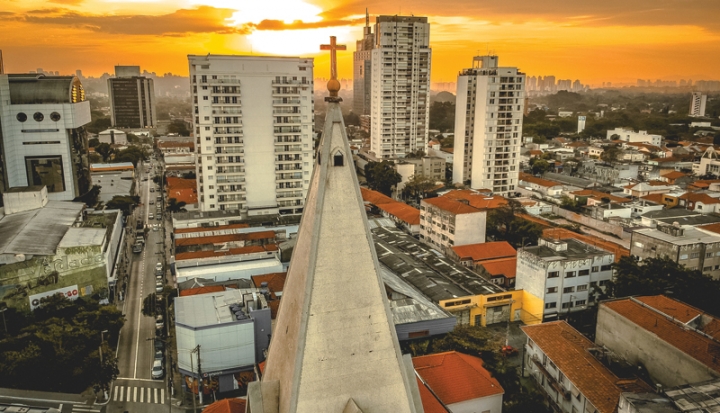The church faces some enormous challenges going forward. That much is obvious. Declining membership, estrangement of young people, sagging cultural relevance, clergy shortages, growing financial crises due to lawsuits, and upkeep on aging facilities all threaten the church’s viability.
As one tangible example of the impact of these challenges, the Archdiocese of Chicago (the third largest archdiocese in the country), has launched a campaign of massive reorganizing with plans to close at least one third of the archdiocesan congregations and maybe as many as half its parish schools. Where vibrant churches, convents, schools, and community centers once existed, large, empty, and hauntingly beautiful buildings remain.
As is the case in so many areas around the country, Chicago’s parishes are disappearing, and the church is scrambling to sell off its real estate in order to cover its debts. From Pittsburgh to New York, Baltimore to Detroit, decline is more the norm than the exception as parishes fold or are forced to merge.
At the same time, the country as a whole is currently experiencing an affordable housing crisis. Rents have been steeply increasing over the past eight years and evictions are on the rise, as is homelessness and housing instability. Two-and-a-half million children in the United States are homeless each year, and 43 percent of U.S. children are from low-income families that struggle to meet basic expenses.
In Chicago, which is one of the more affordable major U.S. cities, a recent study reported that more than 50 percent of Cook County’s households spend more than one third of their monthly income on rent. Furthermore, and contrary to common assumptions, rents in low-income areas are not actually all that lower than in higher-income neighborhoods, so these families have been hit the hardest. Nearly 80 percent of renting households making less than $19,000 a year spend more than half of their income on rent, and 85 percent of families making less than $31,500 commit more than 30 percent of their net wages to these charges.
Given this context, how might the church move toward renewal? Begin with property.
Take for example the Archdiocese of Chicago. As one of the largest real estate owners in the city, the church has a ready solution to this crisis. The church could feasibly establish cooperative ownership companies with local residents aimed at redeveloping vacant or underused church properties as affordable housing units. Such an act of ecclesial enterprise would transform the situation for many of our vulnerable citizens, providing them with affordable and secure access to the basic necessity of housing. That would truly be good news to many.
Further, and as an added bonus, it has the potential to vivify the church in at least two ways: First, imagine the good will between the church and local communities such a solution could create. Now more than ever, people need to know that the church is in it for them and not merely for its own preservation.
Second, such an act of ecclesial friendship would not only rescue a significant number of Chicagoans suffering under the power of the privatized real estate market, transforming the civic structure of the city, it would also return scattered parishioners to these dying congregations by literally welcoming them home with housing. The church could renew and transform parishes by giving them to the parishioners, reconnecting thousands of people to the church at the most intimate and concrete place—where they live.
Though it is not my objective here to articulate a detailed proposal, redeveloping these ailing structures into affordable housing could take a few different routes. In fact, I think it would likely be good for the church not to create a uniform approach to this redevelopment but to work with the local community to determine which option fits best.
In some instances, the church might consider organizing a co-op, even continuing to hold shares itself in the new venture. Public funding is available for such projects. In other spaces, it may make more sense to develop the property for affordable rental units, where the church could set up a democratic co-op of tenants and stakeholders to distribute costs and govern lease arrangements. The key is that the people are incorporated into ownership and oversight of the place they live and thus reconceive it as their parish.
The agrarian contemplative Wendell Berry has suggested that people will not care for their habitat simply because they are supposed to or because they’re paid to do so, even if those payments come in the form of sacred rewards. Instead, people care for things in which they have a direct interest, where that connection is dependable and permanent. That is to say, people care for things that belong to them as much as they belong to it.
I think it’s much the same for a parish. Berry suggests that universal solutions will only be destructive. Instead, we need local thinking—parish thinking—thinking that begins in particular places and takes them seriously. Solutions must start on the ground instead of in the ephemeral corridors of finance or the high offices of asset management.
Renewal of the church is not going to come through a program for survival. That “those who seek to save their lives will lose them” is no less true for our ecclesial institutions than it is for individuals. Instead, renewal will come only by acting in the freedom the church has in Christ and through the power of the Spirit to embody something different, something actually new.
As the Dominican priest Herbert McCabe once said, “If Christianity is not the revolution, nothing else is.” If it is true, following McCabe, that “through the resurrection of Christ the future world is already with us as a disruptive force disturbing the order of the world,” then an approach to the current crisis that looks beyond stabilization or maintenance is not only possible—it’s divinely encouraged.
I am not naively asserting that this would be easy or simple or that it would not require significant ingenuity. Local solutions are no less complicated than large ones much of the time. But surely those acting to make friends by means of unrighteous mammon can be just as shrewd (Luke 16:9) in such acts of ecclesial friendship as those who created complex instruments like derivatives, credit-default swaps, and subprime mortgages.
I have no doubt that this proposal will make few in the real estate office of our dioceses and archdioceses happy. But it is exactly here that we need to acknowledge the degree to which we’ve allowed the institution of private property to shape our church. Moreover, recent studies in the field of institutional economics indicate that alternative forms of property can actually be more conducive to growth and broader development. Who besides the church has both the call and ability to create, pilot, and witness to the possibilities of such alternative forms of property for the flourishing of persons and communities?
Given the new round of revelations of yet more clergy sex abuse and cover ups that have recently come to light, a call for changes to the structures of the church has come again to the fore. Some call for changes to the structures of power and authority, but what might it look like to move toward a new kind of institution, one not so structured on free-market privileged forms of property?
We will undoubtedly need to marshal a great degree of innovation. It would require us to develop new ways of thinking theologically about property. Indeed, there’s significant theological precedent for just such a thing. Irenaeus of Lyon, a bishop of the early church, called for mutual provision and the sharing of property among congregants and with those in need. St. Thomas Aquinas taught that property must be subjected to the common good. Indeed, the Cathedral of St. Peter in Belleville, Illinois proves there’s practical precedent for it, too. Rethinking how we purpose our resources and who has access to those resources will be pivotal; there’s no doubt we can be more creative than we have been.
Using physical capital, especially neglected physical capital, to build real, tangible relationships with those living in its communities, Catholic and non-Catholic alike, is exactly the kind of new vision we need.
Not only would experiments in ecclesial enterprise like this greatly help those trying to make it by in these communities, but I imagine it would be a wonderfully adventuresome activity for the numerous folks in our parishes dying of boredom as well. I think many of our people would be quite excited to actually put bricks and mortar on Pope Francis’ call for a new evangelization. At worst it could be a failure, but the church is already failing, so we need not fear that. At best it could comprehensively rehabilitate our declining parishes while offering a truly inviting witness.
We have nothing to lose but many hundreds or even thousands of neighbors and friends to gain. It’s time to give ourselves a renewed church, literally.
This article also appears in the February 2019 issue of U.S. Catholic (Vol. 84, No. 2, pages 17–19).
Image: Sergio Souza on Unsplash













Add comment